
Consumer Insights
Uncover trends and behaviors shaping consumer choices today
Procurement Insights
Optimize your sourcing strategy with key market data
Industry Stats
Stay ahead with the latest trends and market analysis.
The Expert Market Research report, titled “Sugarcane Molasses Based Methylated Spirit Manufacturing Plant Project Report 2025 Edition: Industry Trends, Capital Investment, Price Trends, Manufacturing Process, Raw Materials Requirement, Plant Setup, Operating Cost, and Revenue Statistics” includes various aspects that are critical for establishing a sugarcane molasses based methylated spirit plant. These include infrastructure requirements, transportation requirements, utility specifications, and financial and economic analysis, among others.






The increasing focus on sustainable practices is driving industries to adopt sugarcane molasses-based methylated spirits as a greener alternative to petroleum-based solvents and fuels. Sugarcane molasses, a by-product of sugar production, serves as a renewable resource for producing methylated spirits. By using this by-product, industries can significantly decrease their reliance on fossil fuels, which are major contributors to greenhouse gas emissions. For instance, coal-fired power plants emit approximately 1000 grams of CO2 per kilowatt-hour (g CO2/kWh), while natural gas plants emit around 475 g CO2/kWh. In contrast, renewable energy sources derived from biomass like sugarcane molasses can produce emissions as low as 50 g CO2/kWh over their lifecycle. As per industry reports, Brazil is forecasted to produce about 32.5 billion liters of ethanol in 2024 and with 25.5 billion liters will be coming from sugarcane. This production can contribute to a reduction of approximately 71.1 million tons of CO2 equivalent (MtCO2e) compared to gasoline and diesel, resulting in market growth.
Other elements to consider while establishing a sugarcane molasses based methylated spirit plant include raw material sourcing, workforce planning, and packaging. The production of sugarcane molasses-based methylated spirit relies on several key raw materials, such as sugarcane molasses, which serves as the primary feedstock for fermentation. This by-product of sugar production is rich in nutrients and sugars, making it ideal for converting into ethanol. Additionally, yeast is crucial for the fermentation process, as specific strains are employed to convert the sugars present in molasses into ethanol. Another important component is denaturants, such as methanol or other alcohols, which are added to the ethanol to render it unfit for human consumption. These raw materials are essential for the efficient production of methylated spirit, enabling manufacturers to meet the growing demand for this versatile industrial alcohol across various applications, including solvents, disinfectants, and fuel sources.
Moreover, to help stakeholders determine the economics of a sugarcane molasses based methylated spirit plant, project funding, capital investments, and operating expenses are analyzed. Projections for income and expenditure, along with a detailed breakdown of fixed and variable costs, direct and indirect expenses, and profit and loss analysis, enable stakeholders to comprehend the financial health and sustainability of a business. These projections serve as a strategic tool for evaluating future profitability, assessing cash flow needs, and identifying potential financial risks.
However, challenges such as seasonal fluctuations in sugarcane production and supply chain disruptions may threaten supply stability for sugarcane molasses-based methylated spirit. To combat this, manufacturers can diversify their raw material sourcing and invest in strategic partnerships with local sugarcane producers. By establishing contracts and collaborations with multiple suppliers, manufacturers can ensure a more consistent supply of molasses, mitigating the risks associated with single-source dependencies. Additionally, implementing advanced inventory management systems can help track raw material availability and improve production schedules. This approach can enhance the overall resilience of the production process for sugarcane molasses-based methylated spirits.
Sugarcane molasses based methylated spirit has a long history dating back to the 16th century when sugarcane cultivation and the sugar industry flourished in the Americas. It was commonly used as a sweetener and ingredient in traditional cuisine before the 20th century. Today, methylated spirit is produced by adding a small amount of methanol (5-10%) and colourants to ethanol derived from sugarcane molasses, primarily for use as a disinfectant and solvent.
Sugarcane molasses based methylated spirit is a clear, colourless liquid with a characteristic odour due to the added methanol. The spirit has a density of around 0.79 g/cm³ and a boiling point of approximately 78 °C (172 °F). Its flash point is around 12 °C (54 °F), indicating flammability. Chemically, it is a mixture of ethanol (90-95%) and methanol (5-10%), along with small amounts of denaturing agents and colourants. The high ethanol content provides the spirit with its disinfectant properties, while the methanol addition makes it unfit for human consumption. The pH typically ranges from 6 to 8, however, caution is advised due to the potential health risks associated with methanol exposure.
The production process of sugarcane molasses-based methylated spirit begins with sourcing sugarcane molasses from local sugar factories, which is then stored in tanks. The molasses is diluted with water to achieve the desired concentration for fermentation, after which specific yeast strains are propagated in a controlled environment. The diluted molasses is transferred to fermentation tanks, where the yeast converts sugars into ethanol over several days. Following fermentation, the mixture undergoes multi-pressure distillation to separate the ethanol. Methanol (5-10%) is then added to the distilled ethanol, along with colourants to deter consumption, creating the methylated spirit. Finally, the product is subjected to quality control testing before being packaged in appropriate containers.

Read more about this report - REQUEST FREE SAMPLE COPY IN PDF
The production of methylated spirit from sugarcane molasses involves the following steps:
1. Fermentation of Sugarcane Molasses:
Sugarcane molasses, a by-product of sugar production, contains sugars like sucrose, glucose, and fructose. These sugars undergo fermentation by yeast (Saccharomyces cerevisiae) to produce ethanol (C2H5OH) and carbon dioxide (CO2). The balanced chemical equation for this fermentation is as follows:
C6H12O6 (glucose) → 2 C2H5OH (ethanol) + 2 CO2 (carbon dioxide)
(Glucose → Ethanol + Carbon dioxide)
2. Distillation:
The ethanol produced from the fermentation process is separated from the fermentation broth by fractional distillation. This step removes water and other impurities, resulting in a high-purity ethanol product.
3. Denaturation:
The distilled ethanol is then denatured by adding methanol (CH3OH), making it unfit for human consumption. Additional denaturants like pyridine or kerosene may also be added, depending on the regulations, and intended use of the methylated spirit. The key reaction is simply the mixing of ethanol and methanol:
C2H5OH (ethanol) + CH3OH (methanol) → Methylated spirit
4. Packaging and Distribution:
The methylated spirit is then packaged in appropriate containers and distributed for industrial and domestic uses such as fuel, solvents, or cleaning agents.
Applications and Drivers of Sugarcane Molasses Based Methylated Spirit
Growth of the pharmaceutical and cosmetic sectors directly influences the demand for methylated spirit. This product is widely used as a solvent and disinfectant in these industries, driven by increasing consumer demand for healthcare products and personal care items. The pharmaceutical industry uses methylated spirit as an essential ingredient in hand sanitizers. Sugarcane molasses-based is also used as a solvent in paint manufacturing and as a denaturant in alcohol products, providing a cost-effective alternative to conventional solvents. Its application in clean-burning fuels also positions it as an attractive alternative to fossil fuels, particularly in regions looking to enhance energy sustainability. The growing emphasis on sustainability and renewable resources also propels market growth, as sugarcane molasses is a renewable feedstock. Furthermore, the rise in biofuel production, using molasses for ethanol, enhances the market potential and dynamics.
A detailed overview of production cost analysis that evaluates the manufacturing process of sugarcane molasses based methylated spirit is crucial for stakeholders considering entry into this sector. Furthermore, stakeholders can make informed decisions based on the latest economic data, technological innovations, production process, requirements of raw materials, utility and operating costs, capital investments by major players, pricing strategies, and profit margins. For instance, the economic advantages associated with using sugarcane molasses are substantial as sourcing molasses from sugar production allows industries to use this resource without incurring high raw material costs. In 2024, global sugar production is projected to reach approximately 189.7 million tons, with significant contributions from countries like India and Brazil. For instance, India is expected to produce around 33.7 million tons of sugar in the 2024/25 season, reflecting a 2.2 million ton increase from the previous season. The efficient production of sugarcane results in about 85-100 kg of sugar and 35-45 kg of molasses generated for every ton of sugarcane crushed. This efficiency highlights the low cost associated with sourcing molasses, which allow companies to maintain competitive pricing while adhering to sustainability goals.
Below are the sections that further detail the comprehensive scope of the prefeasibility report for a sugarcane molasses based methylated spirit production plant:
Market Dynamics and Trends: Growth factors such as rising demand for biofuels derived from sugarcane molasses are significantly affecting market conditions in the sugarcane molasses based methylated spirit sector. As countries implement policies favoring biofuel use to reduce reliance on fossil fuels, the production of ethanol from molasses has become increasingly relevant. For instance, India's ethanol blending targets have created a robust market for molasses as a feedstock for fuel ethanol production. The government has set an ambitious goal of achieving 20% ethanol blending in petrol by 2025. As of 2024, ethanol blending has surged from just 1.53% in 2014 to an impressive 15%, with over 545 crore liters blended in the 2023-24 supply year. India's ethanol production capacity has more than doubled in 2024, reaching approximately 1,648 crore liters, which is essential to meet the rising demand for blended fuels.
Additionally, the government is exploring the possibility of blending higher percentages of ethanol in diesel to reduce fossil fuel dependency. As India continues to advance its ethanol blending program, the use of sugarcane molasses as a feedstock is becoming increasingly critical in supporting both economic growth and environmental sustainability. The Environmental Protection Agency (EPA) in USA has also established biofuel volume requirements for 2023-2025. For 2024, the total renewable fuel requirement is set at 21.54 billion gallons. As countries continue to focus on energy independence, the role of sugarcane molasses-derived biofuels is set to grow significantly in the coming years. Understanding these factors helps businesses align their production plans with demands and trends in the sugarcane molasses based methylated spirit market.
Profiling of Key Industry Players: Leading manufacturers of sugarcane molasses-based methylated spirits include companies such as MOJJ, Jubilant Ingrevia, and Balrampur Chini Mills. MOJJ is a prominent supplier of distillery plants in India and has developed advanced fermentation and distillation technologies tailoured for the efficient production of spirits from molasses. Jubilant Ingrevia produces various speciality grades of ethanol from sugarcane molasses, catering to industries such as pharmaceuticals and agrochemicals. Their state-of-the-art plants in Uttar Pradesh and Maharashtra have a combined production capacity of 250,000 litres per day, contributing significantly to the biofuel market.
Balrampur Chini Mills, one of India's largest sugar companies, operates multiple distilleries dedicated to ethanol production, with a total capacity of 1,050 kiloliters per day (KLPD). The company has recently announced expansions to its distillery capacity, further solidifying its position in the ethanol market. Dhampur Sugar Mills is also a major contributor, with a combined distillation capacity of 860 KLPD across its facilities, producing ethanol and other alcohols from sugarcane-based feedstocks. Additionally, Triveni Engineering is increasing its ethanol capacity from 660 KLPD to 1,100 KLPD by using molasses as a key raw material. Furthermore, Godavari Biorefineries stands out as one of the largest ethanol producers in India, boasting an installed capacity of 570 KLPD as of March 2024. Their investments in expanding production capabilities for sugarcane molasses-based methylated spirits position them as leaders in this evolving market.
Economic Analysis: Capital expenditure (CAPEX) analysis provides stakeholders the knowledge about required investments in advanced technologies, efficient machinery, and necessary infrastructure. Investing in high-capacity mixing equipment, such as a continuous mixer or high-shear mixer, can improve production efficiency by 20-30%. Investing in energy-efficient systems, such as combined heat and power (CHP) systems could reduce energy consumption by up to 30%, as these systems use waste heat from production processes to generate electricity and provide heating.
Fluctuations in sugarcane molasses-based methylated spirit prices are influenced by several key factors, particularly the costs of essential raw materials such as sugarcane molasses itself. The price of molasses can vary significantly based on the overall sugar prices and production levels. For instance, as of 2024, the basic price of B-heavy molasses is estimated at around INR 12,614.30 per metric ton, while cane juice prices are approximately INR 3,055 per metric ton when factoring in the cost of sugarcane and syrup preparation. Additionally, the availability of molasses can be affected by seasonal variations in sugarcane harvests and changes in government policies that may impact sugar production and pricing. Government-set prices for ethanol derived from different sugary raw materials can also influence the economics of molasses as a feedstock for methylated spirit production.
Establishing a sugarcane molasses based methylated spirit manufacturing facility requires a comprehensive financial investment that encompasses various elements critical to the project's success. The following sections detail these components:
Projected profit margins and effective product pricing strategies improve overall profitability. Manufacturers might target a profit margin of around 20-30%, achieved through strategic pricing based on raw material costs and prevailing market demand. Effective pricing strategies should consider fluctuations in raw material prices and competitive positioning within the market.
This prefeasibility report aims to equip potential investors and existing manufacturers with crucial insights to make informed decisions in the sugarcane molasses based methylated spirit industry.
*While we strive to always give you current and accurate information, the numbers depicted on the website are indicative and may differ from the actual numbers in the main report. At Expert Market Research, we aim to bring you the latest insights and trends in the market. Using our analyses and forecasts, stakeholders can understand the market dynamics, navigate challenges, and capitalize on opportunities to make data-driven strategic decisions.*
Get in touch with us for a customized solution tailored to your unique requirements and save upto 35%!
Basic Plan
USD 2,699
USD 2,429
Get Startedtax inclusive*
Raw Material and Product Specification, Raw material consumption, Process flow diagram
Machinery Cost, Working Capital
Utilities consumption, Operating cost, Overheads, Financing Charges, GSA , Packaging
Premium Plan
USD 3,699
USD 3,329
Get Startedtax inclusive*
Key Processing Information, Capital Investment Analysis, Conversion Cost Analysis
Raw material consumption and prices, Utilities consumption breakdown, By-Product Credit, Labour Charges Breakdown
Land and Site Cost, Equipment Cost, Auxiliary Equipment Cost, Contingency, Engineering and Consulting Charges
Enterprise Plan
USD 4,799
USD 4,079
Get Startedtax inclusive*
Key Processing Information, Capital Investment Analysis, Conversion Cost Analysis, Variable Cost Breakdown, Investing Cost Breakdown,
Breakdown of machinery cost by equipment, Auxiliary Equipment Cost, Piping, Electrical, Instrumentation
Cost of Construction, Plant Building, Site Development Charges
Land Cost, Development Charges
Dynamic Spreadsheet (Unlocked)
*Please note that the prices mentioned below are starting prices for each bundle type. Kindly contact our team for further details.*

Basic Plan
USD 2,699
USD 2,429
Key Processing Information
Raw Material and Product Specification, Raw Material Consumption, Process Flow Diagram
Capital Investment Analysis
Machinery Cost, Working Capital
Conversion Cost Analysis
Utilities Consumption, Operating Cost, Overheads, Financing Charges, GSA , Packaging

Premium Plan
USD 3,699
USD 3,329
All Contents of Basic Report
Key Processing Information, Capital Investment Analysis, Conversion Cost Analysis
Variable Cost Breakdown
Raw Material Consumption and Prices, Utilities Consumption, Breakdown By-Product Credit, Labour Charges Breakdown
Investing Cost Breakdown
Land and Site Cost, Equipment Cost, Auxiliary Equipment Cost, Contingency, Engineering and Consulting Charges

Enterprise Plan
USD 4,799
USD 4,079
Includes all Report Content
Key Processing Information, Capital Investment Analysis, Conversion Cost Analysis, Variable Cost Breakdown, Investing Cost Breakdown,
Equipment Cost Breakdown
Breakdown of Machinery Cost By Equipment, Auxiliary Equipment Cost, Piping, Electrical, Instrumentation
Land and Construction Cost Details
Land Cost, Development Charges, Cost of Construction, Plant Building, Site Development Charges
Dynamic Excel Cost Model
Dynamic Spreadsheet (Unlocked)
*Please note that the prices mentioned below are starting prices for each bundle type. Kindly contact our team for further details.*
Flash Bundle
Number of Reports: 3
20%
tax inclusive*
Small Business Bundle
Number of Reports: 5
25%
tax inclusive*
Growth Bundle
Number of Reports: 8
30%
tax inclusive*
Enterprise Bundle
Number of Reports: 10
35%
tax inclusive*
How To Order
Our step-by-step guide will help you select, purchase, and access your reports swiftly, ensuring you get the information that drives your decisions, right when you need it.

Select License Type
Choose the right license for your needs and access rights.

Click on ‘Buy Now’
Add the report to your cart with one click and proceed to register.

Select Mode of Payment
Choose a payment option for a secure checkout. You will be redirected accordingly.
Track prices with detailed trend reports.
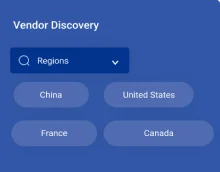
Analyse trade data for supply chain insights.
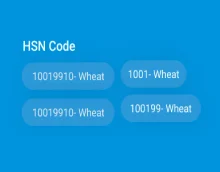
Leverage cost reports for smart savings
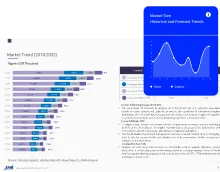
Enhance supply chain with partnerships.
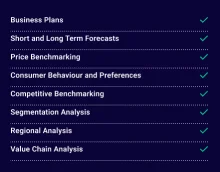
Gain insights to stay ahead and seize opportunities.
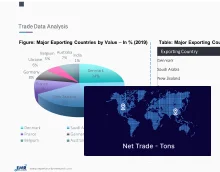
Get insights & trends for a competitive edge.
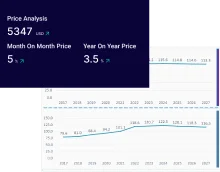
Track prices with detailed trend reports.

Analyse trade data for supply chain insights.

Leverage cost reports for smart savings

Enhance supply chain with partnerships.

Gain insights to stay ahead and seize opportunities.

Get insights & trends for a competitive edge.

Track prices with detailed trend reports.

Analyse trade data for supply chain insights.

Connect For More Information
Our expert team of analysts will offer full support and resolve any queries regarding the report, before and after the purchase.
Our expert team of analysts will offer full support and resolve any queries regarding the report, before and after the purchase.
We employ meticulous research methods, blending advanced analytics and expert insights to deliver accurate, actionable industry intelligence, staying ahead of competitors.
Our skilled analysts offer unparalleled competitive advantage with detailed insights on current and emerging markets, ensuring your strategic edge.
We offer an in-depth yet simplified presentation of industry insights and analysis to meet your specific requirements effectively.



Australia
63 Fiona Drive, Tamworth, NSW
+61-448-061-727
India
C130 Sector 2 Noida, Uttar Pradesh 201301
+91-723-689-1189
Philippines
40th Floor, PBCom Tower, 6795 Ayala Avenue Cor V.A Rufino St. Makati City,1226.
+63-287-899-028, +63-967-048-3306
United Kingdom
6 Gardner Place, Becketts Close, Feltham TW14 0BX, Greater London
+44-753-713-2163
United States
30 North Gould Street, Sheridan, WY 82801
+1-415-325-5166
Vietnam
193/26/4 St.no.6, Ward Binh Hung Hoa, Binh Tan District, Ho Chi Minh City
+84-865-399-124
United States (Head Office)
30 North Gould Street, Sheridan, WY 82801
+1-415-325-5166
Australia
63 Fiona Drive, Tamworth, NSW
+61-448-061-727
India
C130 Sector 2 Noida, Uttar Pradesh 201301
+91-723-689-1189
Philippines
40th Floor, PBCom Tower, 6795 Ayala Avenue Cor V.A Rufino St. Makati City, 1226.
+63-287-899-028, +63-967-048-3306
United Kingdom
6 Gardner Place, Becketts Close, Feltham TW14 0BX, Greater London
+44-753-713-2163
Vietnam
193/26/4 St.no.6, Ward Binh Hung Hoa, Binh Tan District, Ho Chi Minh City
+84-865-399-124
Share